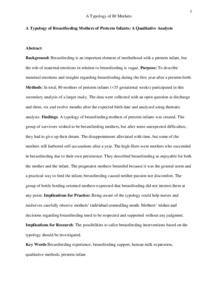A Typology of Breastfeeding Mothers of Preterm Infants: A Qualitative Analysis
Melender HL; Niela-Vilén H; Axelin A; Salanterä S
A Typology of Breastfeeding Mothers of Preterm Infants: A Qualitative Analysis
Melender HL
Niela-Vilén H
Axelin A
Salanterä S
Julkaisun pysyvä osoite on:
https://urn.fi/URN:NBN:fi-fe2021042824647
https://urn.fi/URN:NBN:fi-fe2021042824647
Tiivistelmä
Breastfeeding is an important element of motherhood with a preterm infant, but the role of maternal emotions in relation to breastfeeding is vague.\nTo describe maternal emotions regarding and insights into breastfeeding during the first year after a preterm birth.\nIn total, 80 mothers of preterm infants (<35 gestational weeks) participated in this secondary analysis of a larger study. The data were collected with an open question at discharge and 3, 6, and 12 months after the expected birth date and analyzed using thematic analysis.\nA typology of breastfeeding mothers of preterm infants was created. The group of survivors wished to be breastfeeding mothers, but after some unexpected difficulties, they had to give up their dream. The disappointment alleviated with time, but some of the mothers still harbored self-accusations after a year. The highfliers were mothers who succeeded in breastfeeding because of their own persistence. They described breastfeeding as enjoyable for both the mother and the infant. The pragmatist mothers breastfed because it was the general norm and a practical way to feed the infant; breastfeeding caused neither passion nor discomfort. The group of bottle-feeding-oriented mothers expressed that breastfeeding did not interest them at any point.\nBeing aware of the typology could help nurses and midwives carefully observe mothers' individual counselling needs. Mothers' wishes and decisions regarding breastfeeding need to be respected and supported without any judgment.\nThe possibilities to tailor breastfeeding interventions based on the typology should be investigated.\nBACKGROUND\nPURPOSE\nMETHODS\nFINDINGS\nIMPLICATIONS FOR PRACTICE\nIMPLICATIONS FOR RESEARCH
Kokoelmat
- Rinnakkaistallenteet [19250]
